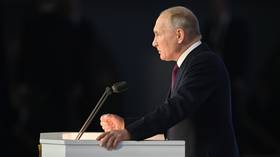Fyodor Lukyanov: What Russia's suspension of the New START nuclear treaty means for the world

The suspension of the New START Treaty was the most important news item in President Vladimir Putin’s Annual Address and a key signal to international players. This is understandable, as it affects what is commonly known as “strategic stability,” i.e. the system of peaceful relations between the nuclear powers.
However, if we try to summarize the main point of the speech, it was mostly a call for Russia to concentrate on its domestic affairs and its own development. There were no plans for the global order in the address. And the outside world in general was given a very minor focus, with a demand (to the West) not to interfere in Russian affairs, and remarks (aimed at everyone else) about opening up new markets and logistical corridors for cooperation.
The pattern of relations with the Western world, as outlined in the message, is disengagement on all fronts: economic, political, financial and ethical. And this is the norm, not an anomaly. Because the Ukrainian issue is at the heart of the dispute, on which Russia and the West have diametrically opposed and irreconcilable views. It has taken a violent form and is likely to drag on for a long time. But the goal remains. And the decision on New START should be seen in this context, as should indications that a resumption of nuclear tests is not unthinkable. We shall leave the military side of the matter to the professionals (and we have brilliant specialists in this field), but this decision is primarily a political one. Let us try to look at it in more detail.
The New START Treaty, recently extended for five years (in 2021), is the latest in a series of agreements that began in the second half of the 1960s and early 1970s. The final phase of the Cold War was generally a period of maximum confrontation, and the documents on missile defence and strategic arms limitation and reduction provided a framework for mutual deterrence between the nuclear superpowers. The confrontation was officially declared over at the turn of the 1990s when political, economic and ideological relations between Moscow and Washington changed.
At the same time, the strategic element remained, and the existence of reduced, albeit very significant, nuclear capabilities remained the basis for building US-Russia relations. It was obvious against whom these arsenals were being deployed – there were no other targets.
Since the US announced its withdrawal from the Anti-Ballistic Missile Treaty in 2002, the course for dismantling the Cold War failsafe system was generally predetermined. When the New START Treaty was drafted in a brief moment of “reset,” many commentators noted that it was likely to be the last of its kind. Not so much because of the changing nature of contacts between Russia and the US, but because the model of bilateral agreements was ill-suited to the rapidly evolving global reality.
In any case, the area of strategic stability was seen as the last opportunity to maintain a business relationship between Russia and the United States, as the main actors responsible for avoiding nuclear Armageddon. While everything else fell apart, at least here we understood each other.
At some point, however, this became rather illusory. And with the outbreak of an open military confrontation in 2022, maintaining the previous approach proved to be completely impossible. In general, a unique and rather dangerous situation has arisen of an acute military confrontation between two nuclear superpowers, in which one is directly involved and the other indirectly, but no less actively.
What does suspension (judging by the experience of recent decades, the first step towards withdrawal) mean in practice? Naturally, experts immediately recall the pointless and extremely costly arms race of the 1970s and 1980s. But there is hope that this experience will not be repeated. Moreover, there has always been a relatively influential faction in Washington that considered all treaties unfavorable and advocated maximum freedom of arms. But in today’s international system, based as it is on asymmetric relationships and imbalances, the old mantra of parity looks a little outdated.
Vladimir Putin’s statement is a deliberate indication that the conflict in Ukraine and the nuclear factor are on the same level. The mention of nuclear tests is intended to indicate the possible trajectory of further moves by Russia if the NATO and US escalation continues, a desire for which was discussed many times at the recent Munich Security Conference.
The end of the era of bilateral treaties and possibly other agreements of that period (multilateral, but initiated by the USSR and the US) is hardly a cause for rejoicing. Any “clean-up” of the international environment, and agreements by major countries on major issues which strengthen the foundations of political culture, are better than an unrestrained display of instinct. But no agreement is permanent. The old model of relations, based on the Cuban missile crisis, has expired. Whether there will be a new one, we will soon find out.
















